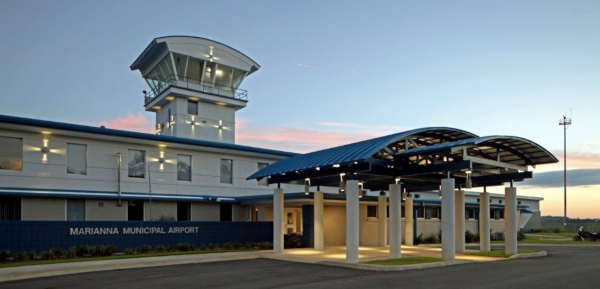Marianna Municipal Airport
The perfect place
Business View Magazine interviews representatives from the Marianna Municipal Airport, as part of our series on best practices of American regional airports.
Marianna Municipal Airport is a general aviation facility located five miles northeast of the city of Marianna, in Jackson County, Florida. With two 4,900-foot-long intersecting runways, the airport has approximately 183,475 square yards of apron area and over 200 tie-downs for aircraft. Its Fixed Base Operator, SkyWarrior Flight Support, Inc. has a space dedicated for a pilot lounge, flight service station, weather briefing area, and pilot training classroom.
Today’s airport has come a long way from its beginnings in 1942, when the United States Army Air Corps established it as a training school. “It was following the attack on, and bombing of, Pearl Harbor,” explains Jim Hart, a member of the Marianna Airport Commerce Park Board. “The Army Air Corps Southeastern Light Training Corps out of Alabama selected the Marianna area for a new training field. Their site included, approximately, 1,700 acres and a small airstrip that had been constructed years earlier. It became an advanced fighter training base with 86 North American, T-6 Texan training fighters stationed there.”

The base closed in 1946 and the entire property reverted to the city. At the time, National Airlines was flying Lockheed Lodestars and Convair 340s in and out, but they would eventually cease operations there and Marianna has not had commercial air flight since. It then operated as the Mariana Municipal Airport until 1953, when the Army Air Field was reactivated as Graham Air Base, a United States Air Force installation under the Air Training Command in response to increased demands for pilots as a result of the Cold War.
In June 1958, the Air Force began replacing their prop-driven T-28s with the first T-37 Tweet jet trainers, and by 1960, the Air Force was fully committed to transitioning to the Undergraduate Pilot Training (UPT) concept at selected Air Training Command installations with longer runways, which would eventually host T-37 Tweet and T-38 Talon jet trainers. Facilities with civilian contractor instructors and short runways became obsolete and were eventually closed in the early 1960s.
“And so, in 1960, Marianna took over the airport again,” Hart continues. “At the time, there were four 5,000- foot runways, necessary to provide crosswind landing for the Air Force craft. But the city discontinued the use of all but two of the runways, the north/south and the east/west runways.” Today, Marianna is a general aviation facility that also continues to see some military aircraft, with a third of the airport’s operations normally being transient military training flights – mostly Army helicopters from Fort Rucker and Navy helicopters from Naval Air Station Whiting Field.
The Airport is owned by the city and relies on city workers to provide non-aviation maintenance and operations. “The airport is an enterprise fund for the city,” says City Manager, Jim Dean. “That means it operates as its own business identity. There is also an airport commerce park and so the whole airport generates revenue from airport operations, hangar rentals, and fuel sales, and also from the other facilities surrounding the airport that are quasi-aviation related and part of the airport commerce park enterprise. In this way, we are financially self-supporting.
Hart explains that the commerce park covers a fairly significant area with some businesses there that require apron access, such as Safari Helicopters, which manufactures and tests their helicopters, but there are also many non-aviation businesses onsite that do not require access to the runways. “We have a new economic development area that includes a piece of property that has been tested and is shovel ready, should a major industrial client want to move in and build,” says Hart. “We are constantly trying to improve the facilities we have, as well as make sure that we can offer a competitive space to call home.”
The next planned improvement, which has already been contracted out, is to increase the north/south runway length from 4,900 to 6,000 feet. With Federal Aviation Administration grants and matching funds from the Florida Department of Transportation, the Airport was able to upgrade its terminal last year and will complete the runway renovations by the end of this year.

“We also have an upgrade to our fueling system which will bring self-serve jet fuel and self-serve low-lead fuel, under contract,” Hart reports. “We have future plans to reconstruct the Industrial Park Drive, which is the main thoroughfare through the commerce park. We have finished a number of projects, lately, like the upgrade to the terminal building, a backup power system, a 500-square-foot expansion to one of the hangars and a new facility for the AIRHeart critical medical transport units based here. There are 34 aircraft, including two multi-engine craft that have hangar space here. We also have corporate hangars that are filled, and so, we are at 100 percent capacity. But there are plans to build more hangar space in the near future.”
There are competitive local airports within a 50-mile radius – Dothan to the North and Panama City to the south. Both of those also have commercial traffic, so they are a different type of airport. But then there is also the Tri-County general aviation airport which is 20 miles to the west, and Donalsonville Municipal Airport in Georgia. “The facilities we have far exceed the two airports east and west of us,” says Hart. “Our runways are better, our instrument approach systems are better, our terminal building is better, the location is geographically perfect for north, south, east, and west traffic is better, so we feel that we are in a much better competitive position when we compare our apples to apples – in other words when we look at similar airports without commercial traffic.”
“This is what we want people to know,” concludes Jim Dean. “It is a very attractive site because we have a lot of facilities already in place and we also have a lot of room for expansion. We have worked on the land on the north side of the runway and done all the due diligence with the city. We have all the infrastructure and testing in place and there is shovel ready land where we can break ground immediately. Add to that, the reality that we are a certified site with a renovated terminal building and that we will soon be able to accommodate larger and heavier aircraft, and you have the perfect location to consider.”
“And don’t forget that we have the space to accommodate parking for an industrial client,” adds Hart, “and that we are making a million dollar improvement to the fueling system and tanks, which will allow after-hour customer access to both jet fuel and general aviation fuel. And last but not least, Marianna has a very cooperative and dedicated City Commission, City Manager, and Public Works Director, all of whom are poised to help you take your business to the next level – and you have the perfect place to put your business.”
AT A GLANCE
WHO: Marianna Municipal Airport
WHAT: A general aviation facility
WHERE: Five miles northeast of Marianna, in Jackson County, Florida
WEBSITE: www.cityofmarianna.com/122/Airport




